
William Starling Burgess was an American yacht designer, aviation pioneer, and naval architect. He was awarded the highest prize in aviation, the Collier Trophy in 1915, just two years after Orville Wright won it. In 1933 he partnered with Buckminster Fuller to design and build the radical Dymaxion Car. Between 1930 and 1937 he created three America's Cup winning J-Class yachts, Enterprise, Rainbow and Ranger.

USS Liberty III (SP-1229), sometimes written Liberty # 3, and also referred to during her naval career as Liberty and as Pilot Boat Liberty, No. 3, was a United States Navy patrol vessel in commission from 1917 to 1919. The Liberty was a pilot boat from 1896-1917. She was a replacement for the pilot boat D. J. Lawlor. After World War I, the Liberty returned to pilot service until 1934 when she was purchased as a yacht.

USS Louise No. 2 (SP-1230), sometimes written Louise # 2 and also referred to during her naval career as Louise and as Pilot Boat No. 2, was a United States Navy patrol vessel in commission from 1917 to 1919. The Louise, was a pilot boat from 1900 to 1917. She was a replacement for the pilot boat Columbia, that was washed ashore in 1898. After the World War I the Louise returned to pilot service until 1924 when she was purchased as a yacht. In 1924, the Boston pilot boat Pilot, took the place of the Louise.

The Sylph was a 19th-century pilot boat first built in 1834, by Whitmore & Holbrook for John Perkins Cushing as a Boston yacht and pilot-boat for merchant and ship owner Robert Bennet Forbes. She won the first recorded American yacht race in 1835. She was a pilot boat in the Boston Harbor in 1836 and 1837 and sold to the New York and Sandy Hook Pilots in October 1837. She was lost in winter of 1857 with all hands during a blizzard off Barnegat, New Jersey. The second Sylph was built in 1865 from a half-model by Dennison J. Lawlor. The third Sylph was built in 1878 at North Weymouth, Massachusetts for Boston Pilots. She was sold out of service in 1901, after 23 years of Boston pilot service.

The D. J. Lawlor was a 19th-century Boston pilot boat built in 1881 at North Weymouth, Massachusetts. The schooner was considered the largest for her type, noted for her seaworthiness and heavy weather performance. She was named after the prominent Boston shipbuilder Dennison J. Lawlor. She was struck by a fishing schooner Horace B. Parker, in 1895, and was replaced by the pilot-boat Liberty in 1896.

The Adams was a 19th-century Boston pilot boat, built in 1888 by Moses Adams at Essex, Massachusetts for Captain John H. Jeffries. She was named for Melvin O. Adams, an American attorney and railroad executive. Her design was by yacht designer Edward Burgess, known for his America's Cup defenders. In 1901, she was one of only five pilot-boats left in the Boston fleet. In 1912, she was sold to haul gravel to Boston, then sold again where she landed in the Portuguese immigrant trade. She was sunk by enemy action during World War I.

The Varuna was a 19th-century Boston pilot boat, built by Montgomery & Howard at Chelsea, Massachusetts in 1890, for a group of Boston pilots. She was designed by yacht designer Edward Burgess, known for his America's Cup defenders. She was the first centerboard pilot-boat in operation in the Massachusetts Bay. The Varuna went out of service in 1912 because of the introduction of steam power into pilot-boats. She was later sold to Stephen Simmons to be used as a trading vessel between ports in the Spanish Main in 1913.

The Northern Light was a 19th-century yacht, built in 1839 at the Whitemore & Holbrook shipyard for Colonel William P. Winchester, a Boston merchant. She was designed by Louis Winde, an early yacht designer and shipbuilder. She sank en route to California in 1850. A second Northern Light, was built in 1927 and bought by the Boston Pilots' Association to serve as a pilot-boat from 1934 to 1941. She was sold to the United States Army in 1941 to serve in the war effort during World War II.

The Edward E. Barrett, or Edward E. Bartlett, was a 19th-century two-masted Sandy Hook pilot boat, built by C. & R. Poillon in 1883 and designed by William Townsend. She helped transport New Jersey maritime pilots between inbound or outbound ships coming into the New York Harbor. She was one of the pilot boats that survived the Great Blizzard of 1888. In the age of steam, the Barrett ended her pilot commission and was sold in 1904.
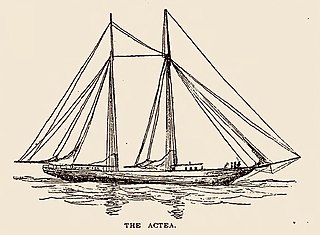
The Actaea, or Actea, was a 19th-century Boston yacht built in 1880 by Weld and David Clark of Kennebunk, Maine for David Sears, Jr., of Montgomery Sears of Boston. She was purchased by a group of New York Sandy Hook Pilots in 1890. She was one of the largest and fastest pilot boats in the fleet. In the age of steam, the Actaea was sold in 1896 to John J. Phelps of the New York Yacht Club and used as a pleasure yacht.
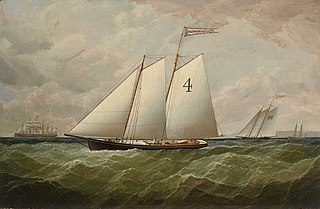
The Abraham Leggett was a 19th-century New York pilot boat built by Daniel Westervelt at the Westervelt & Co. shipyard. She helped transport New York City maritime pilots between inbound or outbound ships coming into the New York Harbor. In 1866, Pilot Michael Murphy was on the Abraham Leggett when the bark Emilie ran into the pilot boat. In 1879, the Abraham Leggett was hit and sank by the steamship Naples from Liverpool. She was replaced by the pilot boat Alexander M. Lawrence.
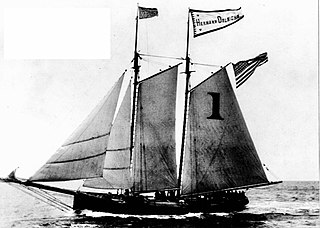
The Hermann Oelrichs was a 19th-century Sandy Hook Pilot boat, built in 1894 by Moses Adams at Essex, Massachusetts for a group of New York Pilots. She helped transport New York City maritime pilots between inbound or outbound ships coming into the New York Harbor. The Herman Oelrichs was said to be the fastest of the New York pilot fleet. She was built to replace the pilot boat Hope, that was wrecked in 1890.

The Friend was a 19th-century pilot boat built by Daniel D. Kelley & Holmes East Boston shipyard in 1848 for Boston pilots. She helped transport Boston maritime pilots between inbound or outbound ships coming into the Boston Harbor. The Friend was one of the last of the low sided, straight sheared schooners built in the 1840s for Boston pilots. The second Boston pilot boat Friend was built in 1887. Her name came from the older Friend that was in the service in the late 1840s. Captain Thomas Cooper sold the Friend to New York pilots in 1893. Cooper replaced the Friend with the pilot-boat Columbia in 1894.

The Fleur de Lis was a 19th-century yacht and pilot boat built in 1865 by J. B. Van Deusen for Captain John S. Dickerson of the New York Yacht Club. She was bought by pilot Franklin B. Wellock and became the Boston pilot boat No. 7. She was known as one of the best pilot boats in the Boston Harbor. By 1904, the pilot boat Fleur de Lis was lying in a graveyard for old boats in East Boston.

The Coquette was a 19th-century yacht and pilot boat, built in 1845 by Louis Winde, at the Winde & Clinkard shipyard in Chelsea, Massachusetts for yachtsmen James A. Perkins. Her design was based on a model by shipbuilder Dennison J. Lawlor. The Coquette was a good example of an early American yacht with a clipper bow. As a yacht, she won the attention for outsailing the larger New York yacht Maria at the second New York Yacht Club regatta in 1846. Perkins sold the Coquette to the Boston Pilots' Association for pilot service in 1848. She continued as a pilot boat until 1867 when she was sold as a Blackbirder to be used on the African coast.
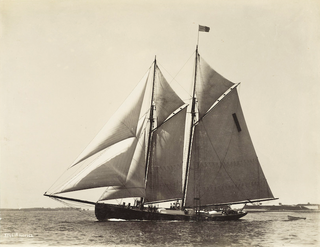
The America, No. 1 was a 19th-century American pilot boat built in 1897 for Captain James H. Reid Sr. of Boston and designed by Boston designer Thomas F. McManus. The Boston America did not resemble her famous namesake, yacht America, rather she was designed with a fishing schooner "Indian header" bow. After serving 21 years in the Boston Pilots' Association, the America was sold to David W. Simpson of Boston in 1918.

Moses Adams, was an Essex County shipbuilder. He had his own shipyard and built eighty-five schooners and pilot boats. Adams died in Essex, Massachusetts in 1894.
Ambrose A. Martin, was a 19th-century Boston, Massachusetts yacht and boat shipbuilder. He built the Ambrose A. Martin shipyard in 1882 at Jeffries Point, East Boston, where he built many notable Boston yachts and schooners. Martin died in Boston in 1934.

Gracie was a 19th-century Boston pilot boat built in 1869 at the Edward A. Costigan shipyard in Charlestown, Massachusetts. The schooner was used by Boston pilots and was sold to North Carolina pilots in 1881.
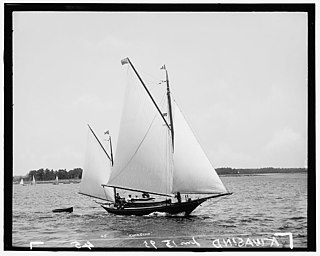
Elbridge T. Gerry was a 19th-century New York Sandy Hook pilot boat built in 1888 at the Robinson & Waterhouse shipyard in City Island, Bronx. She was named in honor of Elbridge Thomas Gerry, a commodore of the New York Yacht Club. She served as a pilot boat from 1888 to 1896, when she was sold for offshore yachting cruises. Her name was changed to Kwasind, after the strongman in Henry Wadsworth Longfellow's Song of Hiawatha.



















